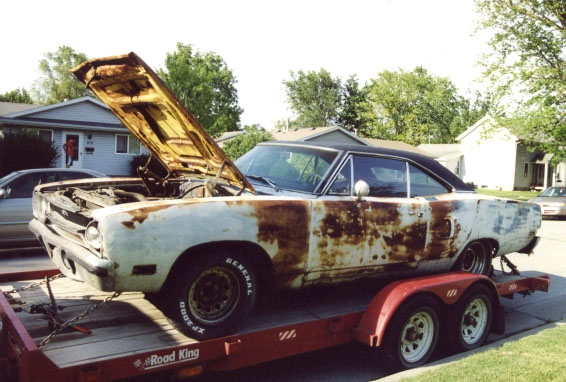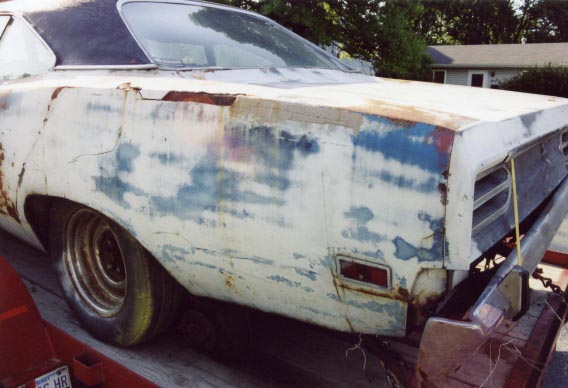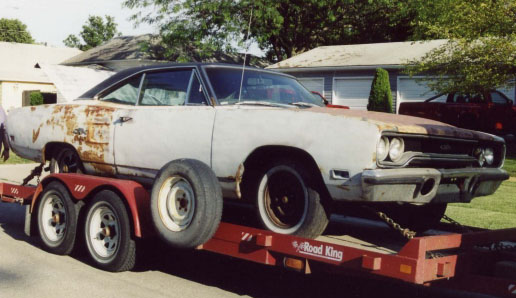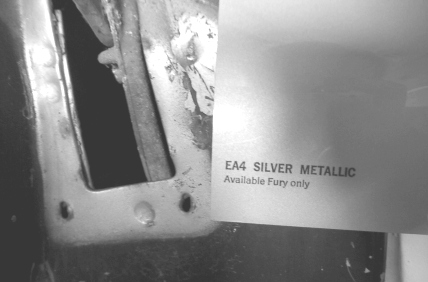


SECOND KNOWN 999 PAINT CODE 1970 GTX LOCATED
text and photos by Roger Wilson
I first became aware of this special 1970 GTX when the owner e-mailed me the fender tag numbers in February 2004. The 999 paint code, of course, caught my attention right away. I only have one other 1970 GTX in the registry with that code and it was painted a burgundy color. This current car had been repainted numerous times so the original color was in question.
In December 2004. the car showed up on eBay but didn't meet the reserve price. Since I was the high bidder, a deal was agreed upon later to purchase the car (in Michigan), however, I was soon notified that he wanted it picked up within several weeks. Since I wasn't too excited to make a winter trip with a car trailer to Michigan, I contacted club member Milt Wood, who lived near where the car was. He graciously agreed to pick the car up for me and keep it at his place until I could come in the spring.
This GTX came from the St Louis assembly plant, originally scheduled to be built there May 1, 1970. It was ordered with the standard 440 4-barrel with the optional 18-spline Hemi 4-speed with a pistol grip shifter coming out of a floor-mounted console. 3.54 gears were ordered with the Dana 60 rearend. A black vinyl top complimented the special order paint. The light package, clock/tach, AM radio with rear speaker, rear bumper guards, hood performance paint, woodgrain steering wheel, door edge trim and 14" Road wheels were also options ordered by the original owner. The build sheet was with the car as well as the original fender tag when I bought the car to help authenticate the above mentioned options.
I picked up the car in June from Milt's and stopped at Sue and Ed George's on the way home so they could look it over. We just quickly looked it over and it appeared to be original Petty Blue paint under the trunk lid. After removing the trunk GTX emblem, again Petty Blue was found. Also, it was observed that the car was much more damaged by rust than first thought.
When I got the car home, I inspected it more carefully. The GTX had numerous metal patches in the trunk. The trunk floor itself was off who-knows-what vehicle as the non-original gas tank with straps that had the J-bolts attached near the rear bumper instead of by the rear axle. The GTX had a non-running 318 with automatic transmission as well as a column shift steering column with an aftermarket floor shift for the automatic transmission.
The front fenders were off of an FC7 purple car, the driver's door was off an EB5 blue car and the standard power bulge hood was off a yellow car!
So, what was the original color of this GTX? I noticed that there was a fair amount of Petty Blue overspray, which could only mean it had at one time been repainted Petty Blue. I removed the rear quarter glass rubber seal which had blue overspray and found shiny original paint--EA4 Silver Metallic. Looking in the trunk at the support braces and under the vinyl top also showed the silver paint--not Petty Blue. The engine compartment, which had black paint peeling off, also showed a lot of silver paint on the firewall and radiator support. I was a little disappointed this 1970 GTX was not Petty Blue, however, it is probably the only 1970 GTX that was painted the EA4 Silver Metallic color. Shown below are photos of the 999 GTX and the fender tag.
The photos below show the 999 coded 1970 GTX as we hauled it home. You can see it's been used and abused though the passenger side of the car is in much better shape than the driver's side. You can see the Petty Blue paint that we found showing through on most of the car's panels. The driver's side quarter had been heavily damaged, some large patches had been welded in and a very thick layer of bondo was applied. The bondo was cracking and falling out along the top edge. Some crude work had been done and all of this was evident from inside the trunk. It's too bad that this rare car was allowed to get in such a state of disrepair.



Cars that were ordered by the customer to be painted in a color that was not available for that particular model were coded 999. The 1970 GTX could have been Petty Blue, Omaha orange or Silver Metallic. According to David Patik, there is no other code anywhere on these special order cars or their paperwork to signify which color it was actually painted. To determine what color the car was originally, you have to find an inner-most place on the car where it could not have been repainted to hopefully discover the original color. Shown below is the paint color match on the GTX. It was originally painted EA4 Silver Metallic.


Shown above is the GTX's original fender tag. Codes are as follows from bottom left to right:
| E86
= 375 hp 440 4 bbl V8 D21 = A833 4-speed manual transmission RS23 = Plymouth Satellite Special 2-door hardtop U = 440 4bbl HP V8 0 = 1970 model year G = St Louis, MO Assembly Plant 221175 = car's serial number 999 = Special Order Paint Color P6XA = Premium vinyl bucket seats, charcoal and black TX9 = Black upper door frame 501 = May 1st scheduled production date 116297 = order number V1X = Black vinyl roof A01 = Light package |
A33
= Track Pak (3.54 Dana) C16 = Console C55 = Bucket seats G31 = Manual right hand outside mirror J25 = 3-speed variable wipers L31 = Hood turn signal indicators M21 = Drip rail mouldings N85 = tachometer R11 = AM radio V21 = Hood performance paint V6X = Black longitudinal stripe Y39 = Special order 26 = 26" Radiator |